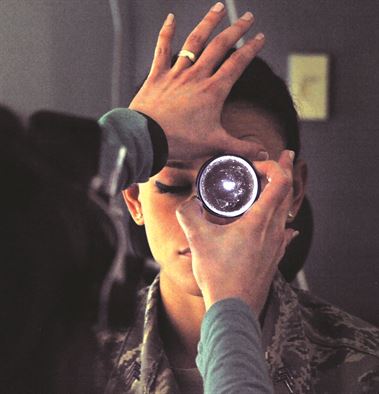
“I could see so well right after my cataract surgery, but I feel like my vision has gotten worse since then.”
Patients reporting this type of symptom often have developed posterior capsular opacification, or PCO, behind the intraocular lens (IOL) implant. PCO is a relatively common occurrence after cataract surgery, but it can often leave patients worried or frustrated, especially if they have opted for premium lens implants. Fortunately for the patient, this side effect of cataract surgery is very simply and quickly treated. The procedure to remove PCO is called Nd:YAG laser posterior capsulotomy (YAG capsulotomy). Patients are relieved to hear that the procedure is painless, takes only a few minutes to perform, and it can instantly improve one’s vision.
When cataract surgery is performed, the capsule in front of the lens is opened, but the capsule behind the lens is left intact. Residual lens epithelial cells migrate to the posterior capsule, which then proliferate causing PCO. When enough of these cells build up on the posterior capsule, they can cause cloudiness and scattering of light, which interferes with the patient’s quality of vision.
PCO is the most common side effect of cataract surgery. Oftentimes, PCO is noticeable to the examining doctor within days of the surgery, but it also could be delayed months or years. It more frequently affects younger patients. The incidence of posterior capsular opacification varies in different studies, and is cited as occurring in 30% to 50% of patients. Due to the length of time that passes before PCO develops, patients may forget that the possibility of its development was discussed prior to their cataract surgery.
Symptoms of PCO include blurry, cloudy, or hazy vision, decreased best-corrected visual acuity, glare or haloes around lights, decreased contrast sensitivity, and ghosting or shadowing of vision.
Not every patient with PCO needs to have a YAG capsulotomy if the amount of their haze is mild and if they are asymptomatic. However, if the patient reports symptoms which interfere with their daily activities, then a YAG capsulotomy is indicated. Sometimes if the haze has become so dense that it impairs the ability to see the retina and to monitor the patient’s retinal health, the laser may also be indicated.
The YAG laser (YAG Capsulotomy) is used to create an opening in the posterior capsule in the patient’s visual axis. Using short, high-power pulses, the laser applies a series of focal ablations to photodisrupt and disintegrate the cloudy capsular tissue. The procedure is generally painless and completed in a matter of minutes. The pupil is dilated so the eye surgeon can visualize the extent of the capsular haze. Intraocular pressure-lowering drops are instilled in the eye to minimize a post-operative pressure spike. The eye is numbed with a topical numbing drop, and the patient sits upright in a slit lamp biomicroscope, just as they do in the exam room. Surgeons often use a capsulotomy lens which makes gentle contact with the eye, but the eye is numb, so the patient should not feel pain. Small clicks or pops may be heard during the procedure as the surgeon creates an opening in the capsule. After completion, another drop of pressure-lowering medication is instilled in the eye, and the patient’s eye pressure is checked shortly after the procedure, and then the patient is discharged. The patient returns for a post-operative visit to check for complications. Generally speaking, the YAG laser posterior capsulotomy results in improved visual acuity in 83% to 96% of eyes.
Some floaters are normal after the YAG laser posterior capsulotomy (YAG Capsulotomy) procedure due to the laser breaking up the capsule, but these floaters should resolve within a few days. However, after the procedure, if the patient should experience increasing amounts of new floaters, flashes of light, curtain over their vision, or drastically reduced vision, they should return to the office immediately. These symptoms may be warning signs of retinal detachment, which is a more serious complication of YAG capsulotomy. Other complications include post-operative pressure spike, inflammation, macular edema, damage to the lens implant, movement in lens implant position, corneal edema, and vitreous prolapse.
YAG capsulotomy is a procedure that can very quickly restore a patient’s vision after cataract surgery. Patients are thrilled with the results and sometimes wonder why they had waited so long to come back in to see what was causing their vision decrease.
Read more of YAG laser at Milan Eye Center.
Read:
Make an appointment today at one of our eight convenient Atlanta-area locations.
Schedule an Appointment Online
Or call 678-381-2020